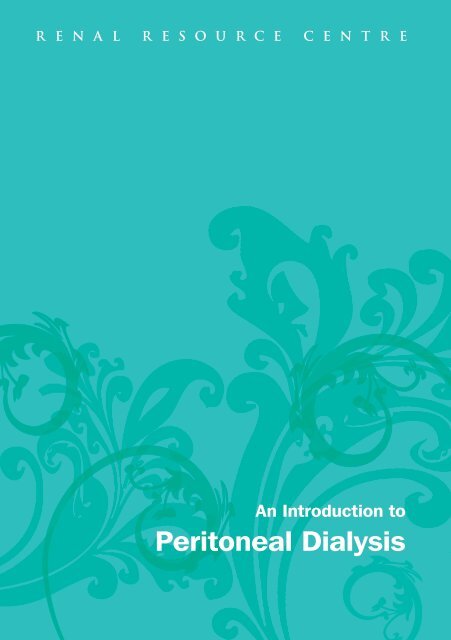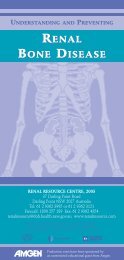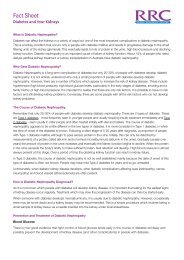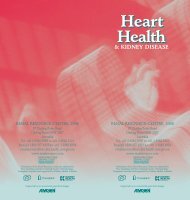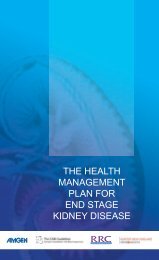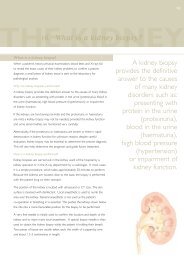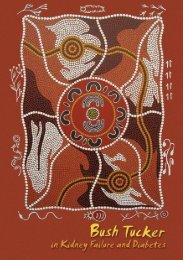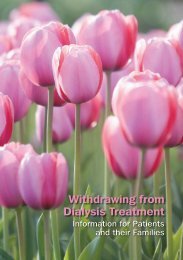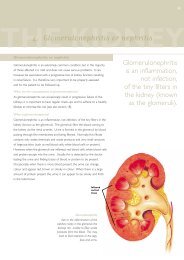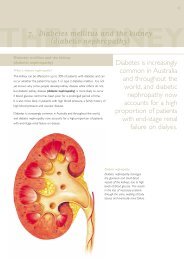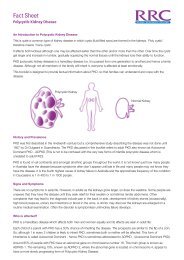An Introduction to Peritoneal Dialysis - Renal Resource Centre
An Introduction to Peritoneal Dialysis - Renal Resource Centre
An Introduction to Peritoneal Dialysis - Renal Resource Centre
Create successful ePaper yourself
Turn your PDF publications into a flip-book with our unique Google optimized e-Paper software.
R E N A L R E S O U R C E C E N T R E<br />
<strong>An</strong> <strong>Introduction</strong> <strong>to</strong><br />
Peri<strong>to</strong>neal <strong>Dialysis</strong>
<strong>An</strong> <strong>Introduction</strong> <strong>to</strong><br />
Peri<strong>to</strong>neal <strong>Dialysis</strong>
Preface<br />
This booklet has been written <strong>to</strong> provide prospective dialysis patients with some general<br />
information about kidney function and specific information about peri<strong>to</strong>neal dialysis . A<br />
companion booklet on haemodialysis is also available and it is recommended that you read<br />
both, especially if your renal physician has indicated that both treatments are medically<br />
suitable for you. Understanding why, when, where and how each form of dialysis is<br />
performed, will allow you <strong>to</strong> better consider which form of treatment will best suit you.<br />
Like many thousands of Australians before you, facing the prospect of dialysis treatment is<br />
daunting. No doubt you have many questions and many fears about what it will entail and<br />
how it will change your life. Most of all, you probably wonder if it will keep you well enough<br />
<strong>to</strong> enjoy a long, full and active life. Rest assured that both peri<strong>to</strong>neal and haemodialysis<br />
are very effective forms of dialysis and that there are currently over 10,000 Australians<br />
receiving dialysis treatment. Furthermore, there are over 7,000 Australians living with kidney<br />
transplants.<br />
After accepting the inevitable need for dialysis treatment, the next step is <strong>to</strong> decide which<br />
form of treatment will best suit you. There are two basic forms of dialysis - haemodialysis<br />
and peri<strong>to</strong>neal dialysis. Deciding which treatment is appropriate will depend on many fac<strong>to</strong>rs.<br />
There may be medical reasons why your renal physician will recommend one over the other.<br />
In many cases, the choice will be entirely yours and will be influenced by several nonmedical<br />
fac<strong>to</strong>rs. The choice of treatment might be determined by your place of residence<br />
and the practicalities of attending for treatment. You may wish <strong>to</strong> consider your personal<br />
and family circumstances and how each form of dialysis will impact on those. It is always<br />
useful <strong>to</strong> consider how dialysis can be incorporated in<strong>to</strong> your work, study, social life, leisure<br />
activities, business and holiday travel requirements.<br />
Australia boasts some of the best results in the world in caring for people with kidney failure<br />
and is a world leader in home haemodialysis. These successful outcomes are a result of not<br />
just access <strong>to</strong> the best medical care and leading edge technology but are also influenced<br />
by the partnership developed between you and your renal team. Hopefully, by reading this<br />
booklet and also attending educational sessions about your treatment options, you will be<br />
well placed <strong>to</strong> participate in that partnership and so successfully manage your treatment,<br />
whatever form it may take.<br />
In this booklet, we have attempted <strong>to</strong> anticipate your anxieties, fears, doubts and questions<br />
about peri<strong>to</strong>neal dialysis. However, a booklet cannot replace speaking with your physician<br />
and the staff of your renal unit. Knowing your individual circumstances, they are best<br />
positioned <strong>to</strong> guide you through the process of choosing the right treatment option.<br />
With the prospect of future treatment and lifestyle changes ahead, try <strong>to</strong> take things slowly<br />
and don’t panic. What now seems overwhelming will soon be part of your routine. Read the<br />
information in this booklet carefully. We hope that it will help you <strong>to</strong> understand peri<strong>to</strong>neal<br />
dialysis and if and how it can benefit you. We wish you every success and good health.<br />
Denise O’Shaughnessy<br />
Senior Social Worker<br />
<strong>Renal</strong> <strong>Resource</strong> <strong>Centre</strong><br />
March 2010
This publication has been supported by an educational grant from Amgen.<br />
<strong>An</strong> <strong>Introduction</strong> <strong>to</strong> Peri<strong>to</strong>neal <strong>Dialysis</strong><br />
© 2010<br />
RENAL RESOURCE CENTRE, 2010<br />
37 Darling Point Road<br />
Darling Point NSW 2027<br />
Telephone: +61 2 9362 3995 or<br />
+61 2 9362 3121<br />
Freecall: 1800 257 189<br />
Facsimile: +61 2 9362 4354<br />
renalresource@nsccahs.health.nsw.gov.au<br />
www.renalresource.com
Contents<br />
Normal Kidney Function.................................................................................. 1<br />
Chronic Kidney Disease and Kidney Failure....................................................... 2<br />
<strong>Dialysis</strong>......................................................................................................... 4<br />
Haemodialysis................................................................................................ 5<br />
Peri<strong>to</strong>neal <strong>Dialysis</strong>.......................................................................................... 5<br />
Peri<strong>to</strong>neal <strong>Dialysis</strong> Advantages......................................................................... 7<br />
Peri<strong>to</strong>neal <strong>Dialysis</strong> Disadvantages.................................................................... 8<br />
Peri<strong>to</strong>nitis...................................................................................................... 9<br />
Methods of Peri<strong>to</strong>neal <strong>Dialysis</strong>....................................................................... 10<br />
Continuous Ambula<strong>to</strong>ry Peri<strong>to</strong>neal <strong>Dialysis</strong> (CAPD).......................................... 10<br />
The Exchange Procedure............................................................................... 11<br />
Au<strong>to</strong>mated Peri<strong>to</strong>neal <strong>Dialysis</strong> (APD)............................................................... 12<br />
Peri<strong>to</strong>neal <strong>Dialysis</strong> for Children....................................................................... 12<br />
Peri<strong>to</strong>neal <strong>Dialysis</strong> & The Diabetic Patient....................................................... 13<br />
Peri<strong>to</strong>neal <strong>Dialysis</strong> Education......................................................................... 13<br />
Going Home................................................................................................. 13<br />
Ongoing Care............................................................................................... 14<br />
Diet............................................................................................................ 14<br />
Medications................................................................................................. 14<br />
Exercise...................................................................................................... 16<br />
Relationships & Body Image.......................................................................... 16<br />
Pregnancy & Contraception............................................................................17<br />
Holidays...................................................................................................... 18<br />
<strong>Dialysis</strong> Supplies.......................................................................................... 18<br />
A Final Note................................................................................................. 19
Peri<strong>to</strong>neal <strong>Dialysis</strong><br />
Normal Kidney Function<br />
The kidneys are two of your vital organs and are located in the back of the<br />
abdominal cavity on either side of the spine, slightly above the small of the back.<br />
Each kidney is bean shaped, weighs approximately 150 grams and measures<br />
11cm x 6cm (the size of a clenched fist).<br />
Each kidney is composed of millions of minute filters which remove waste products<br />
and excess fluid from the blood.<br />
The major function of the kidneys is <strong>to</strong> control the fluid and chemical balance of the<br />
body. In addition, the kidneys produce and regulate three main hormones:<br />
Erythropoietin: Stimulates the bone marrow <strong>to</strong> produce red blood cells.<br />
A decrease in red blood cell production may lead <strong>to</strong> the condition anaemia.<br />
Renin: Assists <strong>to</strong> control blood pressure.<br />
Active Vitamin D: Stimulates the absorption of calcium from the blood in<strong>to</strong> the<br />
bones <strong>to</strong> keep them strong.<br />
The kidneys help maintain the chemical and fluid balance of the body. The kidneys<br />
are located in the back of the abdominal cavity, on either side of the backbone,<br />
slightly above the small of the back.<br />
page 1
Chronic Kidney Disease and Kidney Failure<br />
When the kidneys cease <strong>to</strong> function normally, resulting in a build up of waste<br />
products (<strong>to</strong>xins) and fluid in the body, the kidneys are said <strong>to</strong> be “failing”. Kidney or<br />
renal failure may be acute or chronic.<br />
Acute Kidney Injury<br />
Acute kidney injury may occur following severe blood loss, serious kidney infection<br />
and various types of kidney disease. The kidneys suddenly cease <strong>to</strong> function but<br />
usually recover with treatment.<br />
Chronic Kidney Disease<br />
Chronic renal failure means that kidney tissue has been destroyed gradually over<br />
a long period of time - usually months or years. Many people are unaware of the<br />
problem until more than 70% of kidney function has been lost. The aim of early<br />
detection of kidney disease and treatment (diet and medication) is <strong>to</strong> prevent or<br />
slow down progression of the disease. However, in some cases, the progression<br />
<strong>to</strong> end stage renal failure, when dialysis or transplantation is necessary, is not<br />
preventable.<br />
The most common causes of end stage renal failure in Australian <strong>to</strong>day are diabetes<br />
mellitus, glomerulonephritis, hypertension and polycystic kidney disease.<br />
End Stage Kidney Disease<br />
End stage renal failure occurs when the kidneys can no longer function adequately<br />
and survival depends on either dialysis or transplantation. You have probably<br />
reached or are approaching this stage of kidney disease and your present<br />
treatment is aimed at easing the load on your damaged kidneys and minimising the<br />
accumulation of waste products in your body.<br />
Causes Of Chronic Kidney Disease<br />
• Glomerulonephritis: Inflammation of the kidney.<br />
• Diabetes Mellitus: Damage <strong>to</strong> the small blood vessels of the kidneys.<br />
• Polycystic Kidney Disease: Kidney tissue destroyed by cysts.<br />
• Reflux Nephropathy: Backward flow of urine causing kidney damage.<br />
• Hypertension: High blood pressure.<br />
• Gout: Excess uric acid in the blood.<br />
page 2
Peri<strong>to</strong>neal <strong>Dialysis</strong><br />
• Connective Tissue Disorders: Lupus Nephritis, Polyarteritis Nodosa,<br />
Scleroderma.<br />
• Congenital and Hereditary Abnormalities<br />
• S<strong>to</strong>nes and Other Obstructions<br />
• <strong>An</strong>algesic Nephropathy: Kidney damage due <strong>to</strong> excessive intake of pain killing<br />
tablets or powders.<br />
Symp<strong>to</strong>ms you may be experiencing at the moment<br />
• Retention of fluid causing<br />
breathlessness and swelling<br />
• Tiredness<br />
• Headaches<br />
• Poor memory and concentration<br />
• Irritability<br />
• Sleep disturbances<br />
• Feeling washed out<br />
• Itchiness<br />
• Nausea and loss of appetite<br />
• Weight loss<br />
• Altered sexual function<br />
You will require dialysis when these symp<strong>to</strong>ms are no longer effectively controlled by<br />
your present treatment. Following the commencement of dialysis, you will notice a<br />
marked improvement in your health, as many of these symp<strong>to</strong>ms are minimised or<br />
completely resolved.<br />
The Functions of the Kidneys<br />
Regulation of red<br />
blood cell production<br />
Regulation of<br />
blood pressure<br />
Regulation of the<br />
blood’s acid-basebalance<br />
Elimination of metabolic<br />
<strong>to</strong>xins and excess water<br />
through urine<br />
Regulation of<br />
mineral levels<br />
page 3
<strong>Dialysis</strong><br />
<strong>Dialysis</strong> is the process of cleansing or filtering the blood and removing excess fluids.<br />
The filter used <strong>to</strong> cleanse the blood in dialysis treatment is a semi-permeable<br />
membrane, i.e. a thin material with holes large enough <strong>to</strong> let small particles (up <strong>to</strong> a<br />
particular size) through but small enough <strong>to</strong> retain large particles.<br />
The body’s excess water and waste products filter from the blood across the<br />
membrane and are washed away by the dialysis solution. Large particles, such as<br />
blood cells and proteins, stay behind in the blood where they continue <strong>to</strong> do their<br />
work.<br />
There are two methods of dialysis treatment: Haemodialysis and<br />
Peri<strong>to</strong>neal <strong>Dialysis</strong><br />
Both haemodialysis and peri<strong>to</strong>neal dialysis work equally well when treatment is<br />
undertaken as prescribed and when people take good care of themselves. If you<br />
are medically a candidate for either type of dialysis treatment, it is best <strong>to</strong> select a<br />
treatment based on your lifestyle, daily schedule, activities and personal preference.<br />
Many fac<strong>to</strong>rs such as age, where you live, medical condition and support system<br />
will influence the decision. If you find that the treatment chosen as your first<br />
option does not really suit you, it may be possible <strong>to</strong> change <strong>to</strong> another form of<br />
dialysis. You are not necessarily permanently committed <strong>to</strong> one form of dialysis.<br />
It is also sometimes medically necessary <strong>to</strong> change over from one form of dialysis<br />
<strong>to</strong> another. You may wish <strong>to</strong> discuss the likelihood of this with your renal physician.<br />
BODY<br />
<strong>Dialysis</strong><br />
Solution<br />
P E R IT O<br />
Waste<br />
Products<br />
Extra<br />
Fluid<br />
Excess Fluid<br />
Waste Products<br />
Dextrose<br />
N EU M<br />
A semi-permeable membrane is used <strong>to</strong> filter the blood during dialysis. The<br />
membrane has tiny holes that will let small particles (like waste products) and<br />
excess water through but keep large particles (like blood cells) back.<br />
page 4
Peri<strong>to</strong>neal <strong>Dialysis</strong><br />
Haemodialysis<br />
In haemodialysis, the blood is circulated and cleansed outside the body.<br />
The blood is withdrawn through a needle inserted in a blood vessel in the arm<br />
or leg. The needle is attached by plastic tubing <strong>to</strong> a haemodialysis machine.<br />
The machine pumps the blood out of the body and through an “artificial kidney”<br />
containing a synthetic semi-permeable membrane. Only a small amount of blood<br />
(200 - 220 ml) is out of the body at any one time.<br />
The haemodialysis machine keeps the blood moving through the artificial kidney<br />
while wastes and fluid are being filtered out. It then returns the cleansed blood <strong>to</strong><br />
the body through a second needle in the same blood vessel.<br />
Those who need long-term haemodialysis treatment, use the haemodialysis<br />
machine for 4 <strong>to</strong> 6 hours at a time at least three times a week. Some people<br />
have a machine at home and dialyse alone or with the help of a partner. They may<br />
dialyse more frequently and for longer hours overnight or during the day. Others<br />
have their treatment as outpatients at a community or hospital dialysis centre.<br />
Because the artificial kidney is not as efficient at filtering the blood as real kidneys,<br />
haemodialysis patients usually follow a special diet <strong>to</strong> limit their intake of salt,<br />
potassium and fluids. Longer and more frequent haemodialysis at home may mean<br />
some of these restrictions can be reduced.<br />
Peri<strong>to</strong>neal <strong>Dialysis</strong><br />
Peri<strong>to</strong>neal dialysis is the oldest form of dialysis. It was first used in 1923. In<br />
Australia in 2007, 22% of all dialysis patients were treated by peri<strong>to</strong>neal dialysis<br />
(ANZDATA, 2008).<br />
In contrast <strong>to</strong> haemodialysis, peri<strong>to</strong>neal dialysis works inside the body using the<br />
body’s own natural PERITONEAL MEMBRANE as the semi-permeable membrane<br />
through which the blood can be filtered. The peri<strong>to</strong>neal membrane (peri<strong>to</strong>neum)<br />
lines the peri<strong>to</strong>neal or abdominal cavity and covers the organs that are contained<br />
within (s<strong>to</strong>mach, liver, spleen, intestines).<br />
During a special procedure requiring a short hospital admission, a soft thin tube<br />
called a peri<strong>to</strong>neal catheter is inserted through the wall of the abdominal cavity. The<br />
catheter provides an opening through which dialysis solution can be instilled in<strong>to</strong><br />
the peri<strong>to</strong>neal cavity. Once this solution is fully instilled, the bag which contained<br />
the solution is disconnected. The peri<strong>to</strong>neal cavity can then be used as a reservoir<br />
for the dialysis solution. The average adult can comfortably hold 2-3 litres of dialysis<br />
solution in the peri<strong>to</strong>neal cavity.<br />
page 5
Although this appears <strong>to</strong> be a large amount of fluid <strong>to</strong> hold in the abdomen, no<br />
discomfort should be experienced. The fluid disperses between the two layers of the<br />
peri<strong>to</strong>neum, causing minimal increase in waist measurement. You may initially be<br />
aware of its presence, but this will decrease over time.<br />
Waste products pass from the bloodstream across the peri<strong>to</strong>neal membrane and<br />
in<strong>to</strong> the dialysis solution. The used dialysis solution is drained from the peri<strong>to</strong>neal<br />
cavity and replaced with fresh solution at regular intervals.<br />
The peri<strong>to</strong>neal catheter is your “access” for dialysis and therefore it will be<br />
permanent. The point at which the peri<strong>to</strong>neal catheter exits your abdomen is called<br />
the exit site.<br />
It is important that the exit site is kept clean and free of infection. To ensure this,<br />
you will be required <strong>to</strong> examine and cleanse your exit site daily. Your exit site care<br />
becomes an extension of your normal showering routine. It is essential that the<br />
catheter is well immobilised. You will be taught how <strong>to</strong> care for your exit site as part<br />
of your peri<strong>to</strong>neal dialysis education.<br />
New Solution<br />
FILL<br />
DRAIN<br />
Used Solution<br />
Peri<strong>to</strong>neal <strong>Dialysis</strong> works inside the<br />
body. <strong>Dialysis</strong> solution flows through a<br />
tube in<strong>to</strong> the abdominal cavity where<br />
it collects waste products from the<br />
blood.<br />
Periodically, the used dialysis solution<br />
is drained from the abdominal cavity,<br />
carrying away waste products and<br />
excess water from the blood.<br />
page 6
Peri<strong>to</strong>neal <strong>Dialysis</strong><br />
Peri<strong>to</strong>neal <strong>Dialysis</strong><br />
Advantages<br />
The following are the advantages of peri<strong>to</strong>neal dialysis:<br />
> Continuous <strong>Dialysis</strong> Peri<strong>to</strong>neal dialysis keeps pace with the body’s own natural<br />
processes by cleansing the blood continuously rather than intermittently, as in<br />
haemodialysis. Due <strong>to</strong> the continuous nature of peri<strong>to</strong>neal dialysis, a steady<br />
blood chemistry is achieved and maintained, therefore minimising the need for<br />
dietary restrictions. Generally, continuous dialysis results in an improved feeling<br />
of well-being.<br />
> Self Care <strong>Dialysis</strong> No helper required.<br />
> Simple To Learn & Perform short training period. (1~2 weeks)<br />
> Minimal Fluid and Dietary Restrictions<br />
> No Needle Punctures Required<br />
> Ease Of Travel<br />
> Minimal Cardiovascular Stress<br />
> Overnight <strong>Dialysis</strong><br />
> Compact, Portable<br />
page 7
Disadvantages<br />
The following are the disadvantages of peri<strong>to</strong>neal dialysis:<br />
> Peri<strong>to</strong>nitis Inflammation of the peri<strong>to</strong>neal membrane usually caused by<br />
bacterial infection. Peri<strong>to</strong>nitis is the major disadvantage associated with<br />
peri<strong>to</strong>neal dialysis, but using a combination of disconnect delivery systems and<br />
good hygiene, the incidence is now much lower than in the past.<br />
> Protein Loss Valuable body protein escapes through the peri<strong>to</strong>neal membrane<br />
in<strong>to</strong> the peri<strong>to</strong>neal solution. These proteins are easily replaced<br />
by increasing protein intake (meats, fish, dairy products, etc) in<br />
your diet.<br />
> Potential For Elevated Blood Lipid (Fat) & Triglyceride Levels Elevated<br />
levels of lipids and triglycerides in the blood may lead <strong>to</strong> a narrowing of<br />
blood vessels. Regular exercise and lipid lowering medications reduces this<br />
complication.<br />
> Peri<strong>to</strong>neal Catheter Permanent access for dialysis.<br />
> Daily <strong>Dialysis</strong> Schedules<br />
> Possible Weight Gain The glucose content of the dialysis solution results in a<br />
higher intake of kilojoules / calories.<br />
> S<strong>to</strong>rage Space Needed For Supplies (the corner of a room or wardrobe)<br />
page 8
Peri<strong>to</strong>neal <strong>Dialysis</strong><br />
Peri<strong>to</strong>nitis<br />
Peri<strong>to</strong>nitis is an infection of the peri<strong>to</strong>neal membrane. It is the major complication<br />
of peri<strong>to</strong>neal dialysis. The introduction of germs in<strong>to</strong> the peri<strong>to</strong>neal cavity causes<br />
peri<strong>to</strong>nitis and usually occurs when there has been a breakdown in the exchange<br />
procedure and peri<strong>to</strong>neal dialysis associated techniques. Every precaution should<br />
be taken <strong>to</strong> prevent peri<strong>to</strong>nitis.<br />
Signs and Symp<strong>to</strong>ms<br />
• Cloudy dialysis solution.<br />
• General abdominal tenderness, which can be severe and can occur quickly.<br />
• Nausea and/or vomiting, diarrhoea. Rise in temperature.<br />
• General feeling of being unwell.<br />
Treatment<br />
As for all types of infections, antibiotics play the major role in peri<strong>to</strong>nitis treatment.<br />
The antibiotics required <strong>to</strong> eradicate the peri<strong>to</strong>neal infection will be given via your<br />
peri<strong>to</strong>neal dialysis solution. The duration of antibiotic treatment will be dependent<br />
upon the type of germ and extent of infection. You will be closely moni<strong>to</strong>red by your<br />
doc<strong>to</strong>r during an episode of peri<strong>to</strong>nitis.<br />
For treatment of peri<strong>to</strong>nitis <strong>to</strong> be effective it must commence as soon as possible.<br />
Peri<strong>to</strong>nitis is preventable!<br />
Your peri<strong>to</strong>neal dialysis education is directed <strong>to</strong>wards the prevention of peri<strong>to</strong>nitis<br />
through the use of disconnect systems for delivering your dialysis solution. By<br />
adhering <strong>to</strong> your learned procedures, peri<strong>to</strong>nitis can be avoided.<br />
page 9
Methods of Peri<strong>to</strong>neal <strong>Dialysis</strong><br />
There are two methods of peri<strong>to</strong>neal dialysis:<br />
1. Continuous Ambula<strong>to</strong>ry Peri<strong>to</strong>neal <strong>Dialysis</strong> (CAPD).<br />
2. Au<strong>to</strong>mated - Peri<strong>to</strong>neal <strong>Dialysis</strong> (APD)<br />
In Australia in 2007, CAPD was used <strong>to</strong> treat 10% of all dialysis patients and APD<br />
was used <strong>to</strong> treat 12% of all dialysis patients. So the method of peri<strong>to</strong>neal dialysis<br />
used in Australia is split almost 50/50 between CAPD and APD.<br />
Continuous Ambula<strong>to</strong>ry Peri<strong>to</strong>neal <strong>Dialysis</strong> (CAPD)<br />
CAPD utilises the peri<strong>to</strong>neal membrane <strong>to</strong> filter the blood on a continuous basis.<br />
<strong>Dialysis</strong> solution is introduced in<strong>to</strong> the peri<strong>to</strong>neal cavity on an average of four times<br />
a day. This means that dialysis solution is constantly within the peri<strong>to</strong>neal cavity.<br />
Around 2-3 litres of dialysis solution is instilled in<strong>to</strong> the peri<strong>to</strong>neal cavity via a simple<br />
exchange procedure. In children the volumes are much smaller and tailored <strong>to</strong> the<br />
size of the child.<br />
Clean Solution<br />
Old Solution<br />
page 10
Peri<strong>to</strong>neal <strong>Dialysis</strong><br />
The Exchange Procedure<br />
This involves draining dialysis solution, which contains waste products and excess<br />
fluid, from the peri<strong>to</strong>neal cavity and instilling fresh dialysis solution back in<strong>to</strong> the<br />
peri<strong>to</strong>neal cavity, so that the cleansing process may begin again.<br />
The exchange procedure is undertaken wherever there is privacy and a clean, welllit<br />
environment: home, office, bathroom. The environment should be clean and free<br />
from drafts and dust.<br />
The single most important consideration in CAPD is asepsis i.e. maintaining very<br />
clean conditions during all procedures. Whilst the exchange procedure is a simple<br />
technique <strong>to</strong> learn, it must be done with great care every time. This is because<br />
there is always a risk of infection.<br />
There are exchange assist devices specifically designed for those who require<br />
assistance performing their exchanges, e.g. patients with visual problems, arthritis<br />
or tremor.<br />
The exchange device assists <strong>to</strong> maintain asepsis of the exchange procedure and<br />
most importantly, your independence.<br />
Prior <strong>to</strong> learning CAPD, the nursing staff will meet with you and assess which<br />
delivery method is best suited for you and whether you will require an exchange<br />
device.<br />
A typical daily CAPD routine might be <strong>to</strong> perform exchanges at the following times:<br />
7am (upon waking), 1pm (lunch time), 5pm (after work) and 10pm (before bed).<br />
Although this routine is flexible and may be adjusted <strong>to</strong> suit your lifestyle, it is<br />
important that a minimum of three hours between exchanges occurs <strong>to</strong> allow<br />
sufficient time for waste products and fluid removal.<br />
Connecting and disconnecting the CAPD system takes only a few minutes. Allowing<br />
for draining, the whole procedure takes approximately 30 minutes. Most people use<br />
this time for reading or watching television.<br />
During the course of your PD therapy, your prescription for dialysis may change.<br />
Changes in your prescription may include the amount of fluid instilled and the length<br />
of time it remains in your peri<strong>to</strong>neal cavity. Your prescription will be adjusted by your<br />
doc<strong>to</strong>r according <strong>to</strong> blood results.<br />
page 11
Au<strong>to</strong>mated Peri<strong>to</strong>neal <strong>Dialysis</strong> (APD)<br />
In APD the exchanges are performed au<strong>to</strong>matically by a peri<strong>to</strong>neal dialysis machine<br />
(cycler).<br />
Your peri<strong>to</strong>neal catheter is connected <strong>to</strong> the cycler each night before going <strong>to</strong> sleep.<br />
While you sleep, the cycler will perform four or more solution exchanges. Upon<br />
waking, simple disconnection from the cycler permits freedom from dialysis for the<br />
rest of the day.<br />
APD may appeal <strong>to</strong> patients of all ages with busy lifestyles who want or need <strong>to</strong> free<br />
up their daytime hours. This option can be discussed with your renal physician and<br />
renal nurses.<br />
In APD, “a cycler” machine controls the dialysis process during the night, while you<br />
sleep. APD is especially appealing <strong>to</strong> patients with busy lifestyles who want <strong>to</strong> free<br />
up their daytime hours.<br />
Peri<strong>to</strong>neal <strong>Dialysis</strong> for Children<br />
Peri<strong>to</strong>neal dialysis is often the preferred treatment for children. With effective<br />
dialysis, good phosphate-calciurn-PTH control and the use of growth hormone,<br />
children on both peri<strong>to</strong>neal dialysis and haemodialysis have an equal opportunity for<br />
growth. The choice between PD and HD is purely based on the individual needs, the<br />
environmental and social aspects of the individual’s lifestyle, the treating centre’s<br />
preference, availability of the service and the physical condition of the patient.<br />
Most children are able <strong>to</strong> use a cycler machine overnight, leaving their daytime<br />
hours free.<br />
The volume of dialysis solution generally<br />
depends on the weight of the child, i.e<br />
50mls of dialysis solution per kilogram<br />
of body weight.<br />
Infants may only require 0.5 litre<br />
(50Omls), while teenagers may need<br />
1.5-2 litres of dialysis solution.<br />
Children on peri<strong>to</strong>neal dialysis are able<br />
<strong>to</strong> enjoy a relatively uninterrupted and<br />
active lifestyle, participating in varied<br />
sports.<br />
page 12
Peri<strong>to</strong>neal <strong>Dialysis</strong><br />
Peri<strong>to</strong>neal <strong>Dialysis</strong> & the Diabetic Patient<br />
Peri<strong>to</strong>neal dialysis is often recommended for diabetic patients. <strong>An</strong>ticoagulant<br />
therapy (Heparin) used in haemodialysis can accelerate the vascular changes<br />
associated with Diabetes Mellitus.<br />
New dialysis solutions have been developed, which are especially suitable for<br />
people with diabetes. This allows for improved control of blood glucose levels.<br />
It is important that your endocrinologist continues <strong>to</strong> manage your diabetes.<br />
Peri<strong>to</strong>neal <strong>Dialysis</strong><br />
Education<br />
Your peri<strong>to</strong>neal dialysis education is<br />
undertaken at a peri<strong>to</strong>neal dialysis<br />
education centre. Most people complete<br />
the dialysis education programme in<br />
less than two weeks as an outpatient.<br />
No one need return home until they feel<br />
completely confident. If you are well, you<br />
may be discharged from hospital and<br />
continue your dialysis education each day<br />
as an outpatient.<br />
Going Home<br />
Continuous Ambula<strong>to</strong>ry<br />
Peri<strong>to</strong>neal <strong>Dialysis</strong> (CAPD) Education<br />
On completion of your dialysis education, the peri<strong>to</strong>neal dialysis nurse may<br />
accompany you home. This is <strong>to</strong> give you confidence in performing the exchange at<br />
home.<br />
Following the initial visit, you will be visited from time <strong>to</strong> time by the peri<strong>to</strong>neal<br />
dialysis staff <strong>to</strong> see how you are progressing.<br />
In the case of country patients, the peri<strong>to</strong>neal dialysis staff may contact the local<br />
community nurse <strong>to</strong> provide assistance, when required.<br />
page 13
Ongoing Care<br />
Line Changes<br />
The line attached <strong>to</strong> your catheter is changed every six months. This is usually done<br />
by the peri<strong>to</strong>neal dialysis nurse using aseptic techniques.<br />
It is important that the line is changed regularly as the plastic materials may<br />
become worn with time and harbour germs.<br />
Peri<strong>to</strong>neal <strong>Dialysis</strong> Clinic Visits<br />
Each one <strong>to</strong> two months you will be required <strong>to</strong> attend the peri<strong>to</strong>neal dialysis clinic.<br />
During these visits a line change may be performed, blood may be taken <strong>to</strong> check<br />
blood chemistry and your general well-being will be assessed. This is a good time <strong>to</strong><br />
talk with the peri<strong>to</strong>neal dialysis nurse regarding any problems you may have.<br />
Seeing Your <strong>Renal</strong> Physician<br />
Your renal physician will see you regularly. Timing this with your peri<strong>to</strong>neal dialysis<br />
centre visit is a good idea. The doc<strong>to</strong>r will review your progress and make any<br />
necessary adjustments <strong>to</strong> your dialysis treatment. Take this opportunity <strong>to</strong> discuss<br />
any difficulties you may be experiencing.<br />
Diet<br />
Peri<strong>to</strong>neal dialysis allows you <strong>to</strong> have a more liberal diet. This will be a welcome<br />
change after the dietary restrictions necessary before beginning dialysis.<br />
However, it is essential that you have a well balanced diet. You need <strong>to</strong> eat much<br />
more protein (meat, fish, dairy products etc.) <strong>to</strong> replace protein which is lost in the<br />
peri<strong>to</strong>neal dialysis solution.<br />
You will be seen by the dietitian, who will advise you on your individual dietary<br />
requirements.<br />
Medications<br />
Medications are a very important part of your treatment. Once stable on peri<strong>to</strong>neal<br />
dialysis, your medication requirements may change. Your renal physician will advise<br />
on these.<br />
page 14
Peri<strong>to</strong>neal <strong>Dialysis</strong><br />
page 15
Exercise<br />
People on peri<strong>to</strong>neal dialysis may gain weight easily. This is caused by:<br />
i) improved appetite<br />
ii) the glucose content of the dialysis solution which gives the body extra<br />
kilojoules /calories.<br />
iii) eating <strong>to</strong>o many sweet or fatty foods.<br />
A regular, gentle exercise program is encouraged <strong>to</strong> prevent obesity, <strong>to</strong>ne up the<br />
muscles and add <strong>to</strong> general well-being.<br />
You should continue <strong>to</strong> play your favourite sports.<br />
You may still be able <strong>to</strong> swim in clean private pools and clean, uncrowded ocean<br />
beaches should present no problems. However, check with your renal team first.<br />
Following a swim or active sport, peri<strong>to</strong>neal catheter exit site care should be<br />
undertaken.<br />
Relationships and Body Image<br />
You may be concerned at first about the presence of the catheter. Will the catheter<br />
be noticeable? The staff will show you how <strong>to</strong> secure the catheter so that it’s not<br />
noticeable. Meeting other patients similar in age and lifestyle be of great help in<br />
learning <strong>to</strong> adjust.<br />
At times you may feel depressed and think that your family and friends don’t<br />
understand. It is important <strong>to</strong> share your feelings and concerns with those close<br />
<strong>to</strong> you, whilst also realising that they <strong>to</strong>o may be affected by your illness and its<br />
treatment. The quality of your relationships depends on communication.<br />
Do talk with the staff if you are experiencing difficulties in your relationships.<br />
Particularly when you are first on dialysis, many personal and family adjustments<br />
need <strong>to</strong> be made and it is helpful <strong>to</strong> talk with someone outside your immediate<br />
situation.<br />
Kidney failure can affect your sexual desires or activity. The causes are varied and<br />
the changes in sexual interest will occur at different times for different people and<br />
will vary in intensity.<br />
Women may notice a decline in their sexual interest and some may s<strong>to</strong>p<br />
menstruating. Men may have difficulty in achieving or maintaining an erection and<br />
their fertility may also be reduced. If you experience these changes, talk it over<br />
with your partner so that it is clear that those changes are related <strong>to</strong> your illness<br />
page 16
Peri<strong>to</strong>neal <strong>Dialysis</strong><br />
and treatment. This may be difficult at first, but by talking through these changes<br />
and your feelings with your partner, you will find that <strong>to</strong>gether you can work <strong>to</strong>wards<br />
resolving them and continue <strong>to</strong> enjoy a satisfac<strong>to</strong>ry relationship. As your sense<br />
of well-being improves, you may notice an improvement in your sexual desires. If<br />
difficulties persist, your renal physician can refer you <strong>to</strong> the appropriate specialist or<br />
counsellor.<br />
You may at first be embarrassed about your peri<strong>to</strong>neal dialysis catheter and it is<br />
best <strong>to</strong> be honest about this with your partner. Sexual activity is perfectly safe but<br />
you must first feel comfortable with the changes in your body. Just give yourself a<br />
little time <strong>to</strong> adjust.<br />
Pregnancy and Contraception<br />
Although women who dialyse have conceived, the chances of the pregnancy<br />
reaching full term with a normal sized baby are low. Men who are on dialysis<br />
can father children, so if pregnancy is not desired, you should discuss the most<br />
appropriate form of contraception with your doc<strong>to</strong>r. It is advised that pregnancy be<br />
postponed until at least two years after transplantation.<br />
Being open and honest with your partner about your thoughts and feelings will<br />
ensure that you can strengthen your relationship and resolve any difficulties as they<br />
occur.<br />
page 17
Holidays<br />
Holidays provide important breaks from your usual environment and routine and are<br />
essential for both you and your family.<br />
Peri<strong>to</strong>neal dialysis will not prevent you from travelling. The dialysis staff can assist <strong>to</strong><br />
plan your holidays and arrange for your dialysis supplies <strong>to</strong> be transported with you<br />
or delivered <strong>to</strong> your holiday location.<br />
As well as travelling in Australia, it is possible <strong>to</strong> travel overseas. Forward planning is<br />
essential. The cost of dialysis supplies overseas will depend upon your destination.<br />
If you plan <strong>to</strong> travel, discuss this with your renal team. Check overseas health<br />
insurance arrangements thoroughly, in case hospital admission is required.<br />
<strong>Dialysis</strong> Supplies<br />
You may be required <strong>to</strong> supply some items <strong>to</strong> assist you <strong>to</strong> perform dialysis. This<br />
should be discussed with your renal unit as some of these items may be found in<br />
your home already.<br />
All disposable equipment necessary for your peri<strong>to</strong>neal dialysis is supplied through a<br />
healthcare contrac<strong>to</strong>r and delivered <strong>to</strong> your home address.<br />
Before you go home, the peri<strong>to</strong>neal dialysis nurse organises your initial dialysis<br />
order <strong>to</strong> be delivered <strong>to</strong> your home.<br />
<strong>Dialysis</strong> supplies will be delivered on a monthly basis. We therefore ask you always<br />
<strong>to</strong> bear in mind that your supplies are very valuable resources and need <strong>to</strong> be<br />
s<strong>to</strong>red carefully and never damaged or wasted. You will be required <strong>to</strong> assist in<br />
the ordering process by giving an accurate s<strong>to</strong>cktake of your supplies. You will be<br />
contacted monthly for this information. If you are unable <strong>to</strong> attend <strong>to</strong> this yourself,<br />
another family member or friend may assist.<br />
page 18
Peri<strong>to</strong>neal <strong>Dialysis</strong><br />
A Final Note<br />
We hope that after reading this booklet, you now have a basic understanding of<br />
peri<strong>to</strong>neal dialysis, how it compares <strong>to</strong> haemodialysis (the alternative method of<br />
dialysis) and how it may fit in<strong>to</strong> your lifestyle. To some degree, its impact and<br />
suitability will depend on your pre-existing health, age, attitude, commitments and<br />
activities and the support of those around you.<br />
It is natural at first <strong>to</strong> feel overwhelmed and apprehensive about the future and how<br />
dialysis will affect your life. Eventually, dialysis will become part of your routine and<br />
combined with your prescribed medications, diet and fluid intake, be an effective<br />
replacement of kidney function. Your renal physician and the staff at your renal<br />
unit will help you <strong>to</strong> make the best possible treatment choice. Information and<br />
counselling will be offered as a routine part of your preparation for dialysis and ongoing<br />
treatment.<br />
If you are already suffering from some other major or complex health problem<br />
and are frail, chronically unwell or in pain, you may be facing a dilemma about<br />
whether dialysis is the right choice for you. In such circumstances, it is perfectly<br />
understandable <strong>to</strong> consider declining dialysis. Discuss any reservations you or you<br />
family may have with your renal physician, who can advise on the treatment that<br />
best matches your special situation.<br />
Take the opportunity <strong>to</strong> talk with your family about the information you have<br />
gathered from this booklet. This will help you <strong>to</strong> be well prepared for further<br />
discussions with your health care team about your treatment choice. The<br />
knowledge and understanding you have acquired will help you <strong>to</strong> regain a sense of<br />
control, when life may seem out of control. Being well informed will also help you<br />
<strong>to</strong> participate more fully in decisions about your immediate and future care and<br />
contributes <strong>to</strong> improved long-term health.<br />
page 19
The <strong>Renal</strong> <strong>Resource</strong> <strong>Centre</strong> is a<br />
national unit established <strong>to</strong> provide<br />
information and educational materials<br />
on kidney disease for patients and<br />
health professionals.<br />
The primary objective of the <strong>Centre</strong><br />
is <strong>to</strong> ensure that patients have easy<br />
access <strong>to</strong> such information, are well<br />
informed and can actively participate in<br />
their own health care.<br />
The <strong>Renal</strong> <strong>Resource</strong> <strong>Centre</strong> is<br />
committed <strong>to</strong> providing education and<br />
service <strong>to</strong> the renal community.<br />
<strong>An</strong> <strong>Introduction</strong> <strong>to</strong><br />
Peri<strong>to</strong>neal <strong>Dialysis</strong><br />
RENAL RESOURCE CENTRE, 2010<br />
37 Darling Point Road<br />
Darling Point NSW 2027<br />
Telephone: +61 2 9362 3995 or<br />
+61 2 9362 3121<br />
Freecall: 1800 257 189<br />
Facsimile: +61 2 9362 4354<br />
renalresource@nsccahs.health.nsw.gov.au<br />
www.renalresource.com<br />
page 20
RENAL RESOURCE CENTRE<br />
37 Darling Point Road<br />
Darling Point NSW 2027<br />
Telephone: +61 2 9362 3995 or<br />
+61 2 9362 3121<br />
Freecall: 1800 257 189<br />
Facsimile: +61 2 9362 4354<br />
renalresource@nsccahs.health.nsw.gov.au<br />
www.renalresource.com


